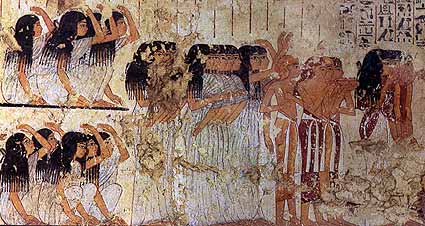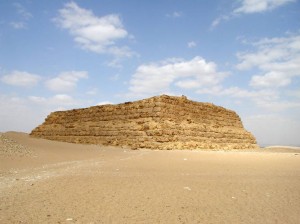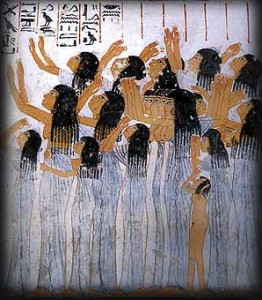 Many of us are vaguely aware of the elaborate funeral customs of the ancient Egyptians. We’ve seen enthralling images of massive pyramids, ancient tombs, exotic mummies, and shining shrines to former lives. These elaborate customs were born of the ancient Egyptian belief that proper burial and preservation were necessary for rebirth in the afterlife. Depending on wealth, Egyptians were buried with a variety of material goods from their former lives, offerings to carry with them into the afterlife.
Many of us are vaguely aware of the elaborate funeral customs of the ancient Egyptians. We’ve seen enthralling images of massive pyramids, ancient tombs, exotic mummies, and shining shrines to former lives. These elaborate customs were born of the ancient Egyptian belief that proper burial and preservation were necessary for rebirth in the afterlife. Depending on wealth, Egyptians were buried with a variety of material goods from their former lives, offerings to carry with them into the afterlife.
The burial customs we’re familiar with developed out of humble beginnings, and varied greatly depending on status and wealth. Early on, before mummification, people who had died were simply buried in the desert, naturally preserved by dehydration. Graves were small pits dug in the sand, stocked with jars of food and drink as well as slate palettes etched with religious “spells”.
The Evolution toward Pyramids and Mummification

mastaba (Source: Wikipedia)
Later, those who had died were buried in coffins to protect from animals in the wild, but it soon became apparent that bodies, also protected from the heat and the dry sand, were not preserved properly. Over time, the ancient Egyptians developed “mummification”, which included the earliest embalmment and wrapping in linen.
For the wealthiest in Egypt, the desert graves eventually evolved into structures made of stacked mud bricks called mastabas, then into step pyramids, and finally into the true pyramids we picture today. Kings would begin construction of their burial pyramids as soon as they took the throne.
Beyond the Pyramids of Egyptian Kings
What about everyone else in ancient Egypt? We picture the elaborate pyramids of Egyptian kings and nobles, but what became of the common man who died in ancient Egypt?
 Even after the evolution of the pyramid, the simple desert burial customs were continued by the poorer classes. Simpler offerings were made, according to the belief in proper burial, but the massive burial sites that have made history were hardly possible for the majority of ancient Egyptians.
Even after the evolution of the pyramid, the simple desert burial customs were continued by the poorer classes. Simpler offerings were made, according to the belief in proper burial, but the massive burial sites that have made history were hardly possible for the majority of ancient Egyptians.
The Kings of Today
While the margin is significantly smaller today, the disparity between the burial of rich and poor in the modern Western world remains just as strong. Think of the difference between a typical burial in your hometown, and those that involve the high-design or green coffins, crematoriums and cemeteries around the world. Despite our beliefs, these contemporary advances in funerary customs are still unattainable to some.
Have you ever pondered the burial of the ancient Egyptian commoner?
Read more:
- Re-Thinking How Our Culture Experiences the Cemetery
- An Ancient Scottish Burial Rite
- Balinese Funeral Ceremony

 Ancient Egyptian Burial Customs: Tombs and Mummification
Ancient Egyptian Burial Customs: Tombs and Mummification


 How Dare You Die Now!
How Dare You Die Now!
 Debating Medical Aid in Dying
Debating Medical Aid in Dying
 “Help Me, Helen”
“Help Me, Helen”














